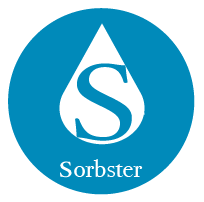Call: 216-533-2343 Email: info@sorbster.com
Sorbster FAQs
What contaminants does the Sorbster line of products remove?
Sorbster® media is formulated for the removal of Mercury, Selenium and Arsenic. Additional metals such as Vanadium, Hexavalent Chromium, Tin, Boron, Lead, Antimony, Molybdenum, Cadmium, Fluoride and Barium are also removed in some waters. The product line includes media specific to Selenium ( Sorbster® Se-1) , Mercury (Sorbster® Hg-1), Fluoride (Sorbster® F-1), Copper (Sorbster® Cu-1) and Silica (Sorbster® Si-1)
How do I use Sorbster® Media?
The media is dry-loaded into standard filtration vessels, backwashed, and then placed into service. The media can be placed into continuous or batch operations with no impact on removal effectiveness. Water flow/hydraulic loading and water-to-media contact time are the operating control parameters.
How much Sorbster® Media will I need?
Adsorbent materials, such as Sorbster® medias, require specific contact time calculated by gpm/ft3. On average we suggest 20 minutes of contact time, so ~135lbs of media per 1GPM of flow.
Can the Sorbster® Media be used in temporary applications?
Sorbster® medias are deployed in standard filtration vessels making it ideal for companies with temporary treatment needs and companies needing fast implementation to remain in compliance.
Are there temperature limits for Sorbster® Medias?
Sorbster® medias perform across a broad temperature range, typically 32 –150 degrees F. This range provides a potential advantage to temperature-sensitive biological treatment.
What do I do with Sorbster® Media when it has reached its capacity?
When spent, Sorbster® media can be disposed in a conventional landfill. Used Sorbster® media typically passes EPA’s Toxicity Characteristic Leaching Protocol (TCLP) test, which means that it need not be considered and disposed of as a hazardous waste.
I have both the selenate and selenite species of selenium present in my wastewater. Will Sorbster® Se still work for my application?
Lab data shows successful results for both species. Treatment effectiveness can be determined by enrolling in our Send Us your Water Program.
*An accurate and comprehensive report of your water’s contaminants will help us to predict if this pretreatment is necessary. If this is not available, we can certainly do it ourselves, but this may add a couple weeks to the timing.
Is there a concern of removed metal contaminants in backwash water?
The media is 1/8” pellets so it doesn’t filter a significant amount of material and backwashing is very infrequent. Since it is not designed to be a particulate filter, we recommend removing suspended materials before our media. (The same as you would do with other adsorbents such as carbon, IX, etc.)
Do you regenerate the Sorbster® Media?
No. The high removal capacity of Sorbster® media means it will treat more water than adsorbents requiring regeneration. There is a major advantage in that there are no regenerant wastes to treat. The media has also been shown to pass a TCLP, which can provide non-hazardous disposal options.
How much does Sorbster® Media cost?
The cost of using Sorbster® media for metals and other contaminate removal is significantly less from both an installation and operating cost evaluation than its competitors. Please contact us for specific pricing.
How do I find out if Sorbster® Medias are a solution to my water treatment need?
Sorbster has a Water Diagnostics program that allows the client to send 55 gallon drum samples of water to our laboratory for testing. Once run, the treated water is analyzed and a report on treatment recommendations is provided to the customer. For more information about the Water Diagnostics Program, please contact us.
Do we need to expand the bed during operation?
No bed expansion is necessary during operation.
Do we need to expand the bed during backwash?
Only 10-15% expansion is needed for backwash. This is accounted for in the design we quote. Note that the media is a 1/8” pellet so the filtration ability is limited and thus backwash is not often needed. If the units require backwash, they return to service capability immediately.
If pretreatment is required, what would this pretreatment entail (e.g., pH adjustment, suspended solids removal, GAC)?
All metals need to be soluble/ionic for our adsorbent to remove them. We evaluate the optimal use of Sorbster® media for each application based on the results from a Send Us Your Water sampling. As an example, if lab testing indicates a significant percentage of insoluble contaminant, we would recommend a conversion of the insoluble portion with an oxidant application such as sodium hypochlorite, hydrogen peroxide, ozone or other oxidant prior to Sorbster® media treatment.
Waters with a pH of < 3 should be pH adjusted to > 3 before pumping through Sorbster® media.
As with any adsorbent media, it is recommended that high levels of organics, especially surface-active agents that might coat the media and block active sites, be removed before pumping through Sorbster® media.
What type of tank configuration is needed?
The media can operate in either upflow or downflow configuration. Standard media filters that operate at nominal feed pressure (e.g. 30 – 60 psig) are usually used. The tank should be configured to enable a hydraulic loading of 1 to 6 gpm per square foot at the recommended water-to-media contact time provided by Sorbster.
Does Sorbster only sell media or can they provide the entire adsorbent treatment system?
Sorbster can provide media and guidance for engineering your system. Sorbster can also provide a complete system of adsorber tanks, media, controls, and any required pretreatment.

Sorbster Inc. © 2025
All rights reserved.
Cleveland, Ohio
216-533-2343
info@sorbster.com

Sorbster Water Treatment © 2025
All rights reserved.
Cleveland, Ohio | Phone: 216-533-2343 | info@sorbster.com
Made In the USA
Terms and Conditions | Site Powered by Teknabyte